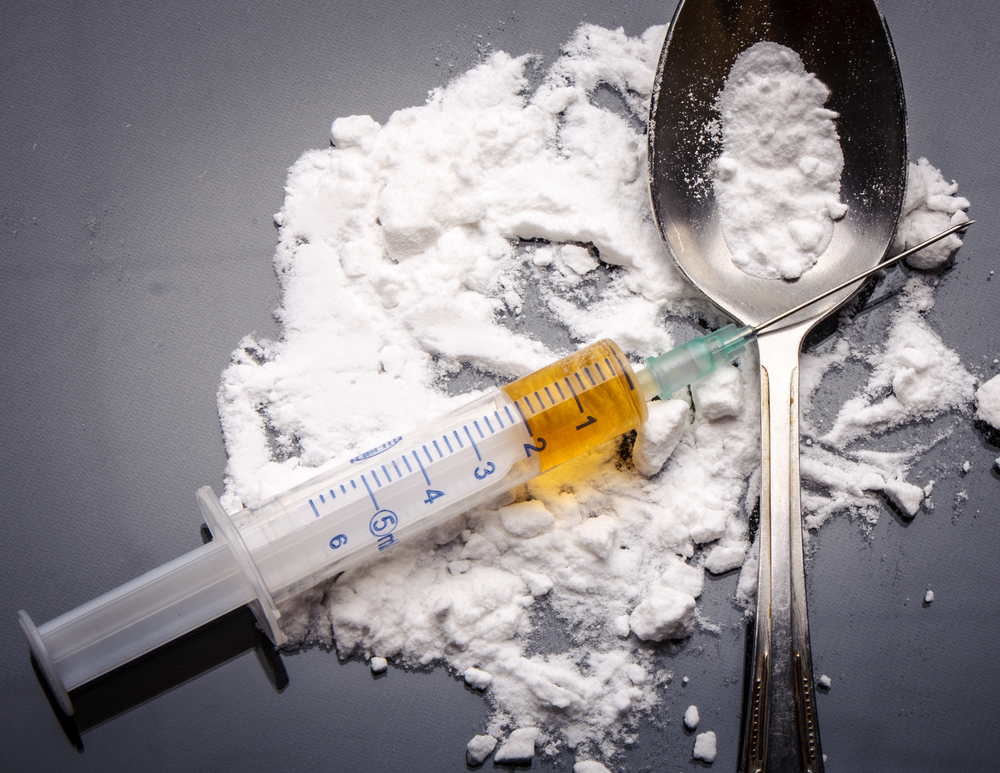10 Interesting Facts About Heroin
What you should know

The same poppy plant that blooms with the fragrant red flowers often depicted in beautiful paintings, as well as produces poppy seeds to top breads and bagels, also makes the substances in heroin, one of the world's most highly addictive opiate drugs.
Heroin is derived from morphine, a naturally occurring substance that can be extracted from the seedpods of some varieties of poppy plants.
Heroin goes by the chemical name diacetylmorphine, and it's the fastest-acting of the opiate drugs. Whether it's injected, smoked or snorted, heroin enters the brain quickly and can cause a range of physical and psychological effects.
"The United States is currently in the midst of a heroin epidemic," said Dr. Daniel Ciccarone, who has done research on heroin and is a professor of family and community medicine at the University of California, San Francisco. The country has experienced heroin epidemics before, but in this latest one, a large set of heroin users are people who have previously abused prescription opioids, he said.
These new users are getting hooked on heroin because it is cheaper and easier to obtain than prescription pain relievers such as OxyContin and Vicodin.
But new users bring old problems. According to the Centers for Disease Control and Prevention (CDC), the rate of heroin-related overdose deaths nearly quadrupled between 2002 and 2013. In fact, heroin claimed the lives of more than 8,200 Americans in 2013.
Here are 10 interesting facts about this dangerous illegal drug. Reading them may give people good reason to avoid trying heroin in the first place.
Get the world’s most fascinating discoveries delivered straight to your inbox.
Being "on the nod" is a dangerous state

When heroin first enters the brain, users will feel a sense of euphoria, or rush. But this high is followed by a period when users experience a state that alternates between drowsiness and wakefulness for several hours. It is referred to as being "on the nod."
"On the nod" is not a medical term, Ciccarone said. He compared it to a college student in a boring lecture who has his head down but is trying to stay awake — his head will nod and drop lower as he gets sleepier, and then his head will eventually jerk awake.
This nodding occurs because heroin is a sedative, and it can cause a person to go from feeling awake but sleepy into such a deep sleep that he or she cannot be shaken awake. This can seem like a desirable state for a heroin user, but it can be the first step on the road toward excess sedation, Ciccarone said.
"Being on the nod is the first baby step on a slippery slope toward overdosing," he said. [The Drug Talk: 7 New Tips for Today’s Parents]
The nod can be especially dangerous if a person is sedated to the point where he or she loses consciousness. People can slip into a comatose state, and sink into overdose, where breathing becomes severely slowed and sometimes stops, Ciccarone said.
Severe itching is a side effect of heroin use

When heroin enters the brain, it converts into morphine, which binds to opioid receptors in the brain and in the body. This produces a surge of euphoria, or rush, and a warm flushing of the skin.
But an unexpected side effect of heroin use is severe itchiness. Opiate drugs can cause histamines — the compounds the body produces during allergic reactions — to be released, and histamines irritate the skin, Ciccarone said. Heroin and other opiates can make people's skin crawl and itch, and they may want to scratch their skin for relief.
A lot of users think something is wrong with their heroin when their skin gets itchy, but it usually means the drug is strong and not contaminated, Ciccarone told Live Science.
Products containing heroin were once sold over the counter

Although it was first made from morphine in 1874, heroin was introduced for medical use in 1898 by The Bayer Company of Germany. Three years earlier, a chemist at Bayer was attempting to create a safer pain reliever that could be a substitute for morphine — one that was less addictive and also had fewer side effects. He accidentally synthesized diacetylmorphine, which he thought was a more dilute form of morphine, and he coined the term "heroin" for it, supposedly for its heroic qualities as a strong medicine.
In the early 1900s, products containing heroin, such as cough syrups and remedies for infant colic, were marketed and sold over the counter in the United States and other countries. Doctors also reported that people who used these products seemed to sleep better.
But within a few years, heroin was found to be two to three times more potent than morphine, and more rapidly absorbed by the brain. Physicians also quickly realized that heroin was even more addictive than morphine.
"Heroin chic" was a '90s fashion movement

In the mid-1990s, there was a movement in fashion photography referred to as "heroin chic." It featured waif thin, emaciated fashion models, such as Kate Moss, who looked in photos as if they were strung out on drugs. The look's other hallmarks included blank stares, dark circles under the eyes and pale skin.
While this cultural phenomenon was taking place in fashion media, a new, cheaper version of heroin was entering the United States from Colombia, and it outcompeted heroin coming from Asia and Southeast Asia, Ciccarone said. The Colombian heroin was so cheap and pure from a street point of view that it increased both the number of heroin users and the depth of their drug use, he said.
In 1997, not long after a fashion photographer died of a heroin overdose, and in the midst of a growing heroin problem in the United States from the influx of cheap heroin, then-President Bill Clinton condemned the "heroin chic" images and advertisements. In a drug policy speech, Clinton suggested the look glamorized addiction in order to sell clothes. [7 Beauty Trends That Are Bad for Your Health]
Around this time, "heroin chic" fell out of favor, and the fashion industry replaced the superskinny look with a new trend: healthier-looking models.
Smugglers "body pack" heroin

People who work as so-called "drug mules" transport illegal drugs from one country to another in extremely risky ways. A case report published in 2009 in the journal Mayo Clinic Proceedings illustrated the dangers involved in trafficking drugs this way.
The report described a 50-year-old woman who was attempting to transport a substantial amount of heroin into the U.S. by carrying it inside her body. To do so, she swallowed 50 pellets of packed heroin, each containing 12 grams of the drug.
Because the woman had a history of drug trafficking, customs agents were suspicious of her, and she was detained at the airport. She was brought to a hospital emergency room, where a physical exam and blood tests showed nothing abnormal about her, but a CT scan of her abdomen revealed numerous rectangular-shaped masses in her colon.
Those rectangular masses, which are visible on the scan, turned out to be pellets of heroin. The woman was given a solution to drink to pass the drugs out of her bowel.
Customs officials recovered 49 intact pellets of packed heroin and took the woman into federal custody.
None of the heroin pellets had caused any infections or obstructions in her body, or opened up while they were within her digestive system.
"Body packing is intensely dangerous," Ciccarone said. If one of those heroin packets explodes in the woman's body, she could overdose and go into a coma, he said. If she quickly received treatment for the overdose, she might survive, he added.
An anti-heroin campaign ran during the Super Bowl

It may seem odd that among the commercials for beer, cars and junk food that aired during the TV broadcast of the 2015 Super Bowl, there was also a 60-second, anti-heroin spot.
The ad, which can be viewed here, was seen only by people in the St. Louis TV market and was created by the National Council on Alcoholism and Drug Abuse.
Designed to increase people's awareness of the deaths in the St. Louis area attributed to heroin or prescription opioid abuse, the ad shows dramatic images of a mother discovering her young son dead in his room after overdosing on heroin. A cheerful-sounding song plays in the background with lyrics describing the son's tragic journey from abusing prescription opiates to heroin addiction.
The ad creators said the contrast between the upbeat music and the grim visuals were intentional, meant to make people pay attention to the commercial, talk about it and recognize the extent of the drug problem in their community.
There is often a question about whether to use positive or negative messaging in drug-education campaigns, Ciccarone said. The first time viewers see an anti-drug ad with negative messaging, such as the one that ran in St. Louis, people might be awed or wowed or bothered by it, he said. But with repeat viewing, people may get immune to these effects.
This commercial did not show what the mother could have done to prevent her son from using heroin, but it could have depicted the steps a parent could take to help an addicted child, Ciccarone said. It could have provided information about calling 911, and having the drug naloxone in a medicine cabinet to administer to help reverse a heroin overdose, he said.
Heroin comes in three different colors

Heroin is sold as a white or brown powder, or as a sticky black substance known as "black tar heroin."
Heroin that comes from Colombia tends to be brown and chalky, Ciccarone said. Heroin from Pakistan and Afghanistan is also brown, and it tends to be sold in Europe, he noted.
White-powder heroin — which is more refined and pure, and used to arrive from Southeast Asia — is becoming rarer in the United States, Ciccarone said. He said much of the powdered heroin sold in the U.S. has fillers or contaminants added, such as sugars, starches and powdered milk.
"Black tar" heroin comes to the U.S. from Mexico, which is the only country that produces it, Ciccarone said. It looks like a black Tootsie Roll; when the drug is cold, it's a hard substance, but when it's warm, it's sticky, like roofing tar.
Black-tar heroin is formed by an industrial process, so the drug is not purified and is lower-grade, Ciccarone said. It's also more similar to opium in its chemical makeup than other forms of heroin, and it has other opioid drugs — such as morphine and codeine — in it, he said.
Some familiar phrases originated from heroin withdrawal symptoms

People who are addicted to heroin have a very difficult time overcoming their addiction, Ciccarone said. Getting off of heroin is a long-term process that requires a great deal of individual commitment and a lot of patience from family and friends. [5 Bad Habits You Should Still Quit]
But our language has been influenced by what happens when people quit using heroin. For example, the expression "kicking the habit" is thought to have originated from the kicking leg movements seen in people going through heroin withdrawal.
During heroin use, a person's muscles become lethargic and heavy, and move slowly, Ciccarone said. So when a heroin abuser goes through withdrawal, his or her leg muscles may become twitchy, crampy and uncontrollable, which can lead to kicking, he said.
Experiencing cold flashes with goose bumps is another heroin withdrawal symptom that may be responsible for the phrase "going cold turkey."
When a person withdraws from heroin, the tissues in the skin become more active, and it goes from being calm to hyperactive, Ciccarone said. This results in goose bumps and probably led to the notion of going "cold turkey."
These expressions are old terms and likely originated 50 to 70 years ago, Ciccarone said.
Heroin goes by many names

On the street, heroin may be referred to as "H," "horse," "smack," "thunder" and "junk." In some cases, the street word used may refer to the drug's looks or chemicals, such as brown sugar, black tar or hell dust.
Sometimes, it may be called by a brand name, like Toyota or Gucci, especially in inner-city heroin markets, Ciccarone said.
A street name might also be bragging about the potency of the heroin, such as DOA (dead on arrival) or comatose, in which the dealer is making claims about the supposed quality of the drug, Ciccarone said. The various street names for heroin are not meant as a way for users to speak in code to avoid law enforcement, he noted.
The names for heroin that have long been spoken aloud on the street may be disappearing these days because many users are using text messages and cellphones to obtain the drug, Ciccarone said.
Babies can be born addicted to opiates

A baby who was exposed to heroin in his or her mother's womb can be born physically addicted to the drug.
"This is not only true for a woman who has used heroin during pregnancy, but it could also apply to any opiate drug, such as a mother who has been taking methadone (a synthetic opiate used to withdraw from heroin) or prescription opiates," said Barry Lester, a national expert on prenatal drug exposure and a professor of psychiatry and pediatrics at the Brown University Alpert Medical School in Providence, Rhode Island.
When a pregnant woman takes opiates, the developing embryo is regularly exposed to the drug, Lester said. But once born, the baby is cut off from a drug supply it has become dependent on, and goes through withdrawal.
Known as neonatal abstinence syndrome (NAS), its symptoms — such as excessive crying, slow weight gain, fever, irritability and vomiting — usually take about 72 hours to appear in the newborn.
"Hospital nurseries are seeing a major uptick of babies born with neonatal abstinence syndrome," Lester told Live Science. He said this is due to the growing number of women who are abusing prescription opioids.
Although the majority of babies born to women who abuse opiates during pregnancy are born addicted to these drugs, studies have found that about 25 to 30 percent of these babies never develop NAS symptoms, Lester said. [7 Ways Pregnant Women Affect Babies]
Researchers are trying to understand why this happens, and Lester said they suspect there is something fundamentally different about these babies, both genetically and in the makeup of their brains, that may protect them.
Babies who develop NAS need treatment. They are put back on opiates, either morphine or methadone, and these drugs are gradually withdrawn over time until the newborn no longer has symptoms, Lester said.
He said it's unclear whether babies born with NAS have any long-term effects from this early opiate exposure because the studies done so far have shown inconsistent results.
Follow Live Science @livescience, Facebook & Google+.
Cari Nierenberg has been writing about health and wellness topics for online news outlets and print publications for more than two decades. Her work has been published by Live Science, The Washington Post, WebMD, Scientific American, among others. She has a Bachelor of Science degree in nutrition from Cornell University and a Master of Science degree in Nutrition and Communication from Boston University.



